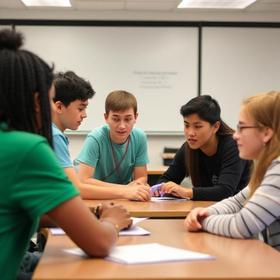Wamogo Regional High School was a public school in Litchfield, Connecticut. It served grades 9 through 12. It was the public high school for the surrounding towns of Morris, Warren, and Goshen.
Serving 379 students in grades 9-12, Wamogo Regional High School ranks in the top 50% of all schools in Connecticut for overall test scores (math proficiency is bottom 50%, and reading proficiency is bottom 50%).
The percentage of students achieving proficiency in math was 35-39% (which was lower than the Connecticut state average of 41%). The percentage of students achieving proficiency in reading/language arts was 75-79% (which was higher than the Connecticut state average of 50%).
The student-teacher ratio of 9:1 was lower than the Connecticut state level of 12:1.
Minority enrollment was 11% of the student body (majority Hispanic), which was lower than the Connecticut state average of 53% (majority Hispanic).
Top Rankings
Wamogo Regional High School ranks among the top 20% of public schools in Connecticut for:
Category
Attribute
Reading/Language Arts Proficiency
Graduation Rate
Student Attention
School Overview
Grades Offered
Grades 9-12
(Supplemental Virtual)
(Supplemental Virtual)
Total Students
379 students
Gender %
Total Classroom Teachers
40 teachers
Year Founded
1955
School Calendar
School Rankings
Overall Testing Rank
#319 out of 939 schools
(Top 50%)
(Top 50%)
Math Test Scores (% Proficient)
35-39%
41%
Reading/Language Arts Test Scores (% Proficient)
75-79%
50%
Science Test Scores (% Proficient)
45-49%
47%
Student-Teacher Ratio
9:1
12:1
American Indian
n/a
n/a
Asian
n/a
5%
Hispanic
7%
31%
Black
1%
12%
White
89%
47%
Hawaiian
n/a
n/a
Two or more races
3%
5%
All Ethnic Groups
Graduation Rate
≥95%
89%
Eligible for Free Lunch
18%
37%
Eligible for Reduced Lunch
9%
6%
School Statewide Testing
School District Name
Source: National Center for Education Statistics (NCES), CT Dept. of Education
Profile last updated: 02/09/2025
Frequently Asked Questions
What is Wamogo Regional High School's ranking?
Wamogo Regional High School is ranked #319 out of 939 schools, which ranks it among the top 50% of public schools in Connecticut.
What percent of students have achieved state testing proficiency in math and reading?
35-39% of students have achieved math proficiency (compared to the 41% CT state average), while 75-79% of students have achieved reading proficiency (compared to the 50% CT state average).
What is the graduation rate of Wamogo Regional High School?
The graduation rate of Wamogo Regional High School is 95%, which is higher than the Connecticut state average of 89%.
How many students attend Wamogo Regional High School?
379 students attend Wamogo Regional High School.
What is the racial composition of the student body?
89% of Wamogo Regional High School students are White, 7% of students are Hispanic, 3% of students are Two or more races, and 1% of students are Black.
What is the student-teacher ratio of Wamogo Regional High School?
Wamogo Regional High School has a student ration of 9:1, which is lower than the Connecticut state average of 12:1.
What grades does Wamogo Regional High School offer ?
Wamogo Regional High School offers enrollment in grades 9-12 (Supplemental Virtual).
What school district is Wamogo Regional High School part of?
Wamogo Regional High School is part of Regional School District 06.
Recent Articles

Bullying, Name-Calling & Put-Downs: Parent Guide 2025
Practical tips for parents to address bullying, name-calling, and put-downs鈥攚ith 2025 data, policies, and expert strategies.

What Is a Magnet School? (2025 Guide)
Explore what a magnet school is, how it works, and its benefits in 2025. Clear explanation for parents, students, and educators.

Cooperative Learning in 2025: Evidence, Best Practices & Challenges
Explore cooperative learning in 2025鈥攏ew data, updated practices, expert insights for educators and families.





